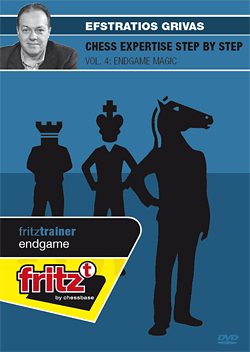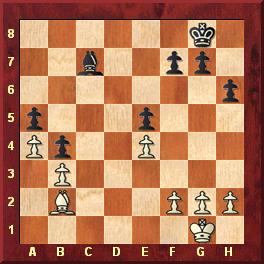


 Efstratios
Grivas: Chess Expertise Step by Step
Efstratios
Grivas: Chess Expertise Step by StepThe last part of the game is where a well educated player can set the opponent the most problems. The weight of each move increases; each mistake can prove very costly, great accuracy is required.
In our times, with the abolition of adjournments and the increasingly faster time-controls, endgame knowledge has acquired greater significance than never before.
This DVD, called ‘Endgame Magic’, tries to cover important parts on this field and help to assimilate knowledge and understand in depth the proper handling of endgame in certain cases. We will examine how to benefit from the isolani in the endgame, how to try to win or defend when a rook and rook-pawn vs a bishop and rook-pawn (on the same side) endgame arise, the technique of the ‘square’ when the advantage of the exchange-up seems to be difficult to capitalise, how to win or defend with a plain queen vs a plain rook, how to benefit from our opponent’s shattered pawns, how to play some specific pawn endings and finally what are the problems of the exchange-up when facing the bishop-pair.
As Laurence Fishburn said in ‘Matrix’, ‘There is a difference
between knowing the path and walking the path’.
Video running time: 4 hours
Video sampler from Efstratios Grivas: Chess Expertise Step
by Step, Vol. 4: Endgame Magic
Earlier this year GM Grivas held a series of lectures for young German talents, in the offices of ChessBase in Hamburg. The aim of this series of lectures is to enable participants to teach young and gifted players in schools and chess clubs, and to educate trainers and chess teachers not only in their own countries but also on an international basis.

Successful chess trainer GM Efstratios Grivas
The material started to develop in early 2004 and was used Grivas' personal training sessions, where he developed a system based on serious sport (chess is treated like a sport) and chess material (focusing on middlegame and endgame). In 2005 this material was first printed in Greek, in a series of training books called ‘Skakistiki Proponisi’ (six volumes, 680 pages). It then appeared in an improved version in an English series ‘Chess College’ (Gambit 2006, three volumes, translator Sotiris Logothetis) and ‘Practical Endgame Play’ (Everyman 2008). It was also translated (in another improved version) into Turkish in 2009. Finally a further improved version appeared in the latest FIDE book for training the trainers called ‘Syllabus’ (FIDE 2010, proofer Andrew Martin).
"I use this material to make my students understand that health and other sport assets are valuable for a chess player's improvement, and not just never-end analysis in openings," says Stratos (as his friends call him). "For example in Turkey, where I am working on my program, all my trainees exercise some physical activity in accordance with their chess education." Since middle of 2006, when he started training youthful Turkish talents, three players have made their grandmaster norms and two more are close to this goal. And a number of IMs have also arisen in the process.
In the meantime Grivas, Adrian Mikhalchishin, Alexander Beliavsky and Georg Mohr are cooperating to produce a total training system, which will appear in 30 books (around 3,000 pages) based on the idea of full training in the middle and endgame. The work is being edited by the Turkish Chess Federation (which has the rights) and for the moment it is printed only in the Turkish language. The project started in early 2010 and it will be completed in 2012.
Trainers (and players) all over the world can use the series presented on the ChessBase news page freely. Any question can be addressed directly to the author: GrivasEfs (at) yahoo.co.uk.
| 1 | Physical and Psychological Factors |
| 2 | Getting to know Ourselves |
| 3 | Building a Repertoire |
| 4 | Chess Literature |
| 5 | Activity of Bishops and Knights |
| 6 | The Backward Pawn |
| 7 | The Art of Exchanges |
| 8 | The Golden Rules of the Endgame |
| 9 | How to Think in Endgames |

Grivas in a lecture session for young German talents
Terminology
This part of the lecture is devoted to cases of Good Bishop vs Bad Bishop and Good Knight vs Bad Knight. But rather than using the terms ‘good’ or ‘bad’, we will mostly opt for ‘active’ and ‘activity’, in order to best understand the comparison between these specific minor pieces.
An active bishop can be a positional or a tactical asset, and therefore a permanent or temporary feature of a position. The active bishop occurs frequently in practice, and its owner can, for a number of moves, dictate the course of the game. He should usually utilize this time to get an attack or generally the initiative going, an important feature in modern chess practice. When there are various fixed pawns on the board, it is important to have a bishop which can attack the enemy pawns. This is known as the good or active bishop. The advantage of having such a bishop is not only that it can threaten the opponent's pawns, but also that it can move around more easily, its own pawns not being in its way. In contrast with all this, there is the bad bishop.
In order to evaluate the presence of a good/bad bishop in any given position, it is important to consider how much material remains on the board. The superiority or the weakness of the good/bad bishop is highlighted as the endgame approaches. And this brings us to the important conclusion that, while the bad bishop can be quite useful at times, this asset diminishes with exchanges or the unsuitable placing of other pieces.
The following three important endings are typical examples:

This type of endgame is always very pleasant for White. Black's bad bishop and his weak a5 and e5 pawns make his life miserable and impose on him laborious defensive duties. White is hardly risking to lose (except if he overdoes it!), but of course the main question is if he can win. In such endgames it is ‘hard’ to claim that White is better; it must be proved that he either wins or that the ending is a draw.
In my opinion White wins, following a four-step plan:
Let's examine all this in practice:

The other two examples will follow soon...
Efstratios GrivasEfstratios Grivas is a grandmaster and highly experienced chess trainer and chess author. He lives in Athens, and he is also a FIDE Senior Trainer (Secretary of the FIDE Trainers' Commission), an International FIDE Chess Arbiter and an International FIDE Chess Organizer. He has represented his country on a great many occasions, winning the fourth position in the World Junior Championship 1985, an individual gold medal at the 1989 European Team Championship and an individual silver medal at the 1998 Olympiad. In 2010 he was awarded the worldwide highly important FIDE TRG Awards – the Boleslavsky Medal (best author) for 2009. |
 |
 |
Grivas: Chess Expertise Step by Step 05.11.2011 – Greek grandmaster Efstratios Grivas is a highly experienced chess trainer and chess author. He has participated in the ChessBase sponsored program of training sessions for talented young players. In addition he has recorded a number of training DVDs, the latest of which deals with rook handling in the endgame, with four hours of personal video instructions. Do not miss this one. |
 |
Grivas Training: Building a Repertoire 18.04.2011 – "In contrast to the middlegame and the endgame, where theory is objective and accepted by everyone, in the opening each chess player makes his choices in accordance with his emotions and his personal experience. No opening loses, no opening wins." World renown chess trainer GM Efstratios Grivas explains how you should build your repertoire in Part 3 of his lecture series. |
 |
Grivas Training: Getting to Know Ourselves 13.02.2011 – Young chess players need to be able to identify the assets and weaknesses of their chess personalities. Many trainers and trainees have wondered how this can be done properly. The basic resource are one's recent games, which are used to produce an "X-ray image" of one's chess-self. GM Efstratios Grivas, a world-class trainer, tells us how to go about it, in Part 2 of his lecture series. |
 |
ChessBase Training with GM Efstratios Grivas (Part 1) 28.01.2011 – How do you help talented young chess players to realize their potential? Working with a world-class trainer is a good way to start. ChessBase has started a program to sponsor a series of training sessions, which started, logically, in our offices in Hamburg. Five young talents got a full-day session with an internationally known chess coach, who has graciously placed his entire lecture at our disposal. |